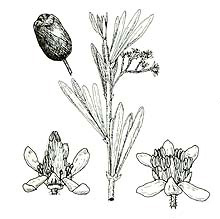Family: Nitrariaceae
Nitraria billardierei
Citation:
DC., Prod. 3:456 (1828).
Synonymy: N. schoberi sensu J. Black, Fl.S. Aust. 486 (1948), non L.
, Zygophyllum australasicum Common name: Nitrebush, Dillon bush.
Description:
Rigid spreading shrub, 1-2 m tall and c. 4 m diam.; branchlets sometimes spiny; leaves thick, glaucous or green, densely covered with appressed hairs, oblanceolate to narrow-oblanceolate, 1-4 cm long, often clustered.
calyx pubescent, 5-lobed; petals 5 (rarely 6), white, 3-4 mm long.
drupe ovoid-oblong, 1-2 cm long, purple, red or golden when ripe, edible.

| Nitraria billardierei twig, femal flower, fruit and male flower.
|
Image source: fig 392a in Jessop J.P. & Toelken H.R. (Ed.) 1986. Flora of South Australia (4th edn).
|
Published illustration:
Cunningham et al. (1982) Plants of western New South Wales, p. 437.
|
|
Distribution:
|
On coastal sand dunes, on flood plains and over-grazed or saline flats, on loam and red-brown clay and gypseous soils.
S.Aust.: NW, LE, NU, GT, FR, EA, EP, NL, MU, YP, SL, KI, SE. all mainland States, in Qld possibly only introduced.
|
Conservation status:
native
Flowering time: mainly Sept. — Nov.
|

SA Distribution Map based
on current data relating to
specimens held in the
State Herbarium of South Australia
|
Biology:
No text
Taxonomic notes:
The Australian populations have been placed by many authors under N. schoberi L., a species extending from European Russia to Central Asia. A full assessment of the differences of the two very closely allied species is needed. The putamen of N. schoberi seems to be smaller than that of N. billardierei, and its leaves are oblong-spathulate to oblong. The chromosome numbers recorded for N. schoberi are 2n = 24, those for N. billardierei are 2n = 48. A thorough comparison of the western and eastern coastal and inland populations (including habit characteristics) is desirable as they may be taxonomically distinct. Some flowers appear to be unisexual, at least functionally, and some plants may be male only. The sex distribution needs further investigation.
Author:
Not yet available
|

